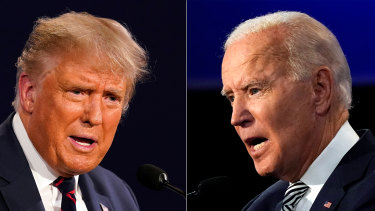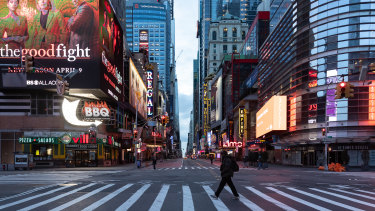‘Hole is getting bigger’: The grim economic reality facing Trump and Biden
The winner of the race for the White House will face a generation of low-to-middle income Americans struggling to get back to work because of a health crisis not seen in more than 100 years.
Whether it’s President Donald Trump or Democratic challenger and former Vice President Joe Biden, the reality is grim: about half of the 22 million who lost their jobs during the pandemic are still out of work.

New hiring is slowing, dimming prospects for the low-wage workers hit hardest by job losses. Infections of the virus that killed more than 225,000 Americans are rising to new records. Hotels, transportation companies and food providers warn that more layoffs are coming, and the government aid that helped many pay the bills is long gone.
Securing a future for a vast, growing underclass “is the most important challenge America faces over the next few years, 10 years, 20 years,” said Gene Ludwig, a former comptroller of the currency under President Bill Clinton and author of “The Vanishing American Dream,” a book about the economic challenges facing lower and middle income Americans.
“We cannot sustain a democratic society that has these kinds of numbers of low and middle income people that aren’t able to have a hope for the American dream and live decently.”
Congressional Democrats and the Trump administration have been trying to negotiate a $US2 trillion ($2.8 trillion) coronavirus aid bill, but many Senate Republicans object to the cost and question whether more stimulus is needed. A deal may not be reached until early 2021.
Savings drying up
That’s going to be too late for some.
Direct cash payments and enhanced unemployment benefits established by the CARES Act, which added $US600 a week to state unemployment benefits, lifted more Americans out of poverty in April even as unemployment soared, according to research by the Centre on Poverty & Social Policy at Columbia University.
People receiving the enhanced benefits were able to spend more, build savings and pay off debt, according to an analysis by the JPMorgan Chase Institute.
But after the benefits expired at the end of July, poverty is once again on the rise – with the monthly poverty rate reaching 16.7 per cent in September from 15 per cent in February, according to the Columbia study. After a decade of decline, hunger is rising nationwide.
Lisandra Bonilla, 46, saved roughly a third of the enhanced unemployment benefits she received after she was furloughed in late March from her job at an employment agency in Florida. “I had saved a lot because I didn’t know what was going to happen,” she said.
It was smart planning: in August her benefits were cut to $US275 a week before taxes, the maximum in Florida, down from more than $US800.
Bonilla returned to work part-time in late September, but now she is struggling to pay the bills on half her previous pay, and fears her savings will be gone by December.

If she isn’t hired full time soon, she needs to find another job.
“We’re trying to shovel ourselves out of the hole, but at the same time the hole is getting bigger,” said Wendy Edelberg, director of the Hamilton Project and senior fellow at the Brookings Institution.
Two factors are particularly worrying, she said. More than 420,000 small businesses shuttered between March and mid-summer, which is more than three times the typical pace, she estimates. And permanent layoffs are also on the rise, hitting 3.8 million in September from 1.3 million in February – similar to levels seen before the 2008 election.
The long-term unemployment trap
Bishop Donald Harper has been on more than 50 job interviews since he was furloughed in March.
Harper, 55, a veteran chef, most recently oversaw five restaurants at an Orlando resort. But with occupancy still low, it’s not clear when he’ll get back to work.
Applications for jobs at super markets or in health care have also been fruitless.
“I can do anything and everything,” said Harper, who also serves as a bishop for a non-denominational church. He is struggling to pay for food and utilities on $US275-a-week unemployment, and three months behind on his $US1,900 a month rent.
“I don’t want to be homeless,” said Harper, who lives with two children ages 10 and 13. He has reached out to more than 20 groups seeking rental assistance, with no luck.
The United States has 2.4 million and growing “long-term” unemployed, officially defined as those who have been out of work for 27 weeks or more. Getting everyone back to work is crucial, but economists say these job seekers are at greater risk of dropping out of the labour market or taking lower paying jobs.
This week, the US Commerce Department is expected to report that Gross Domestic Product surged in the third quarter, thanks in part to fiscal stimulus that kept US workers afloat, but has mostly expired.
Now, people who are out of work or in low-wage jobs need rental support, direct cash payments and food assistance, as well as federal jobs projects and retraining programs, labor economists say.
If elected, Biden has pledged to raise the federal minimum wage, and roll out trillions of dollars in infrastructure and green energy programs. But he’ll need the votes in Congress to do it.
Trump has signalled support for more federal stimulus, but has offered fewer specifics on jobs.
Until help arrives, workers are struggling.
Reuters
Business Briefing
Start the day with major stories, exclusive coverage and expert opinion from our leading business journalists delivered to your inbox. Sign up for the Herald‘s here and The Age‘s here.
Most Viewed in Business
Source: Thanks smh.com